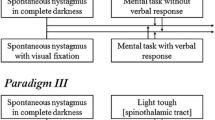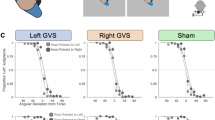Abstract
We recently argued that the specific compensation of spatial neglect by manipulating neck proprioceptive and vestibular input is due to a central “correction” of the disturbed neural transformation process converting the afferent input coordinates from the peripheral sensory organs into a central representation of egocentric space. Both types of stimulation were proposed to induce a reorientation of the deviated or distorted egocentric spatial reference frame. The aim of the present study was to observe this process of reorientation under a condition in which no visual stimulus can attract the subject's attention and thus influence exploration behaviour from outside. We recorded eye movements of normal subjects and of three patients with spatial neglect after right parietal lesions while searching for a non-existent target in complete darkness. It was assumed that the area of the outer space that subjects spontaneously explore under this condition is a direct function of the subject's representation of egocentric space. Ocular space exploration was biased and confined almost entirely to the right side of the midsagittal plane in patients with neglect. This spatial distribution of exploratory eye movements changed remarkably with left-sided neck muscle vibration as well as with left-sided vestibular stimulation using ice water calorics. The spatial area of exploration was significantly enlarged to the contralesional side and the exploration maximum shifted in the same direction. Whereas with both types of stimulation space exploration of patients with neglect was similar to that of normal subjects when not being stimulated, neck proprioceptive and vestibular stimulation in normal subjects induced a quasi neglect-like exploration pattern, i.e. a bias to one side of the objective midsagittal plane. If ocular space exploration was, however, related to the subjectively perceived position of the midsagittal plane in space, eye movements were symmetrically distributed and carried out to both sides of subjective “straight ahead” in all experimental conditions, in normal subjects as well as in patients with neglect. The present results support the above hypothesis and indicate that neck proprioceptive as well as vestibular input directly contribute to the computation of the subject's central representation of egocentric space used for localizing body orientation and for guiding motor behaviour in space.
Similar content being viewed by others
References
Abderhalden E (1926) Lehrbuch der Physiologie in Vorlesungen, Bd 3. Urban & Schwarzenberg, Berlin
Andersen RA, Snyder LH, Li C-S, Stricanne B (1993) Coordinate transformations in the representation of spatial information. Curr Opin Neurobiol 3:171–6
Battaglini PP, Galletti C, Fattori P (in press) Neuronal coding of visual space in the posterior parietal cortex. In: Thier P, Karnath H-O (eds) Parietal Lobe Contributions to Orientation in 3D space. Springer, Berlin Heidelberg New York
Bisiach E, Rusconi ML (1990) Break-down of perceptual awareness in unilateral neglect. Cortex 26:643–649
Büttner U, Buettner UW (1978) Parietal cortex (2v) neuronal activity in the alert monkey during natural vestibular and optokinetic stimulation. Brain Res 153:392–397
Frenzel H (1955) Spontan-und Provokationsnystagmus als Krankheits-Symptom. Springer, Berlin Heidelberg New York
Gainotti G, Tiacci C (1971) The relationship between disorders of visual perception and unilateral spatial neglect. Neuropsychologia 9:451–458
Grüsser O-J, Pause M, Schreiter U (1990a) Localization and responses of neurones in the parieto-insular vestibular cortex of awake monkeys (Macaca fascicularis). J Physiol (Lond) 430:537–57
Grüsser O-J, Pause M, Schreiter U (1990b) Vestibular neurones in the parieto-insular cortex of monkeys (Macaca fascicularis): visual and neck receptor responses. J Physiol (Lond) 430:559–83
Halligan PW, Marshall JC (1991) Spatial compression in visual neglect: a case study. Cortex 27:623–629
Holm S (1979) A simple sequentially rejective multiple test procedure. Scand J Stat 6:65–70
Hornak J (1992) Ocular exploration in the dark by patients with visual neglect. Neuropsychologia 30:547–52
Jeannerod M, Biguer B (1987) The directional coding of reaching movements. In: Jeannerod M (eds) Neurophysiological and neuropsychological aspect of spatial neglect. North-Holland, Amsterdam, pp 87–113
Jung R (1953) Neurophysiologische Untersuchungsmethoden. In: Bergmann G, Frey W, Schwiegk H (eds) Handbuch der Inneren Medizin, Bd V. Springer, Berlin Heidelberg New York, pp 1206–1420
Karnath H-O (1994) Subjective body orientation in neglect and the interactive contribution of neck muscle proprioception and vestibular stimulation. Brain 117:1001–12
Karnath H-O (1995) Transcutaneous electrical stimulation and vibration of neck muscles in neglect. Exp Brain Res 105:321–24
Karnath H-O (in press) Neural space encoding in egocentric coordinates? Evidence for and limits of the hypothesis derived from patients with parietal lesions and neglect. In: Thier P, Karnath H-O (eds) Parietal Lobe Contributions to Orientation in 3D space. Springer, Berlin Heidelberg New York
Karnath H-O, Schenkel P, Fischer B (1991) Trunk orientation as the determining factor of the “contralateral” deficit in the neglect syndrome and as the physical anchor of the internal representation of body orientation in space. Brain 114:1997–2014
Karnath H-O, Christ K, Hartje W (1993) Decrease of contralateral neglect by neck muscle vibration and spatial orientation of trunk midline. Brain 116:383–96
Kinsbourne M (1987) Mechanisms of unilateral neglect. In: Jeannerod M (eds) Neurophysiological and neuropsychological aspects of spatial neglect. North-Holland, Amsterdam, pp 69–86
Kinsbourne M (1993) Orientational bias model of unilateral neglect: evidence from attentional gradients within hemispace. In: Robertson IH, Marshall JC (eds) Unilateral neglect: clinical and experimental studies. Erlbaum, Hillsdale, NJ, pp 63–86
Milner AD, Harvey M (1995) Distortion of size perception in visuospatial neglect. Curr Biol 5:85–89
Mesulam M-M (1985) Attention, confusional states, and neglect. In: Mesulam M-M (eds) Principles of behavioral neurology. Davis, Philadelphia, pp 125–68
Pizzamiglio L, Frasca R, Guariglia C, Incoccia C, Antonucci G (1990) Effect of optokinetic stimulation in patients with visual neglect. Cortex 26:535–540
Rizzolatti G, Gentilucci M, Matelli M (1985) Selective spatial attention: one center, one circuit or many circuits? In: Posner MI, Marin OSM (eds) Attention and performance XI. Erlbaum, Hillsdale, pp 251–265
Robinson DA (1963) A method of measuring eye movement using a scierai search coil in a magnetic field. IEEE Trans Biomed Electron 10:137–45
Rubens AB (1985) Caloric stimulation and unilateral visual neglect. Neurology 35:1019–24
Vallar G, Sterzi R, Bottini G, Cappa S, Rusconi ML (1990) Temporary remission of left hemianesthesia after vestibular stimulation. A sensory neglect phenomenon. Cortex 26:123–31
Vallar G, Bottini G, Rusconi ML, Sterzi R (1993) Exploring somatosensory hemineglect by vestibular stimulation. Brain 116:71–86
Ventre J, Flandrin JM, Jeannerod M (1984) In search for the egocentric reference. A neurophysiological hypothesis. Neuropsychologia 22:797–806
Author information
Authors and Affiliations
Rights and permissions
About this article
Cite this article
Karnath, H.O., Fetter, M. & Dichgans, J. Ocular exploration of space as a function of neck proprioceptive and vestibular input — observations in normal subjects and patients with spatial neglect after parietal lesions. Exp Brain Res 109, 333–342 (1996). https://doi.org/10.1007/BF00231791
Received:
Accepted:
Issue Date:
DOI: https://doi.org/10.1007/BF00231791




